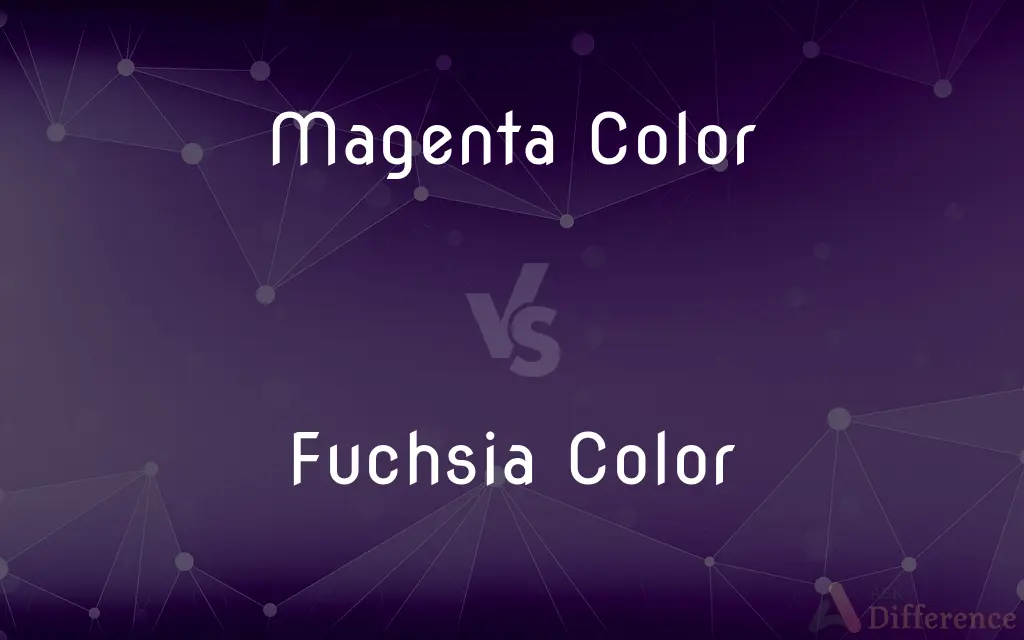Magenta Color vs. Fuchsia Color — What's the Difference?
Edited by Tayyaba Rehman — By Fiza Rafique — Published on December 2, 2023
Magenta Color is a deep pink-red hue, while Fuchsia Color is a vivid purplish-red; both are derivatives of red and blue.

Difference Between Magenta Color and Fuchsia Color
Table of Contents
ADVERTISEMENT
Key Differences
Magenta Color is recognized as a primary color in the subtractive color system (often used in color printing). It's positioned between red and blue on the color wheel. Fuchsia Color, on the other hand, leans more towards a purplish-red, being named after the fuchsia flower which showcases a similar shade.
When examining the RGB color model (used in electronic displays), Magenta Color is created by combining full intensity of red and blue light without green. Fuchsia Color in digital formats is often synonymous with magenta, although in broader contexts, fuchsia retains its purplish-red identity.
Magenta Color often appears deeper and less vibrant than its counterpart. Its depth can sometimes give it a slightly more muted or sophisticated appearance. Fuchsia Color pops out with its vividness, making it a favorite for situations where a bold statement is intended.
In terms of symbolism, Magenta Color is associated with harmony, emotional balance, and creativity. It's seen as a color that fosters compassion and kindness. Fuchsia Color, on the other hand, exudes confidence, boldness, and vivacity, often linked with feminity and charm.
Historically, the term Magenta Color finds its origins from the Battle of Magenta, where the dye was first produced. Fuchsia Color traces its name from the fuchsia plant, named after the German botanist Leonhart Fuchs.
ADVERTISEMENT
Comparison Chart
Origin of Name
Battle of Magenta
Fuchsia plant
Position on Color Wheel
Between red and blue
More towards purplish-red
RGB Representation
Full red and blue, no green
Often same as magenta
Symbolism
Harmony, emotional balance
Confidence, boldness
Overall Appearance
Deep pink-red
Vivid purplish-red
Compare with Definitions
Magenta Color
A primary color in the subtractive system.
The printer was running low on Magenta Color ink.
Fuchsia Color
A vivid purplish-red hue.
She wore Fuchsia Color lipstick to the party.
Magenta Color
Represents harmony and emotional balance.
The artist used Magenta Color to evoke feelings of compassion.
Fuchsia Color
Represents confidence and vivacity.
The Fuchsia Color banner immediately drew everyone's attention.
Magenta Color
Named after the Battle of Magenta.
Historians often relate Magenta Color to its historical origin.
Fuchsia Color
A bold statement color.
Designers use Fuchsia Color when they want to make an impact.
Magenta Color
A color derived from combining red and blue.
The sunset was a blend of orange and Magenta Color.
Fuchsia Color
Named after the fuchsia flower.
The Fuchsia Color of the petals matched her shoes perfectly.
Magenta Color
A deep pink-red hue.
Her dress was a striking shade of Magenta Color.
Fuchsia Color
Often synonymous with magenta in digital contexts.
On her screen, the Fuchsia Color appeared very similar to magenta.
Common Curiosities
How does Fuchsia Color differ from Magenta Color?
While Fuchsia Color is a vivid purplish-red, Magenta Color leans towards a deeper pink-red.
In the digital RGB model, how do Magenta Color and Fuchsia Color compare?
In digital formats, Fuchsia Color is often synonymous with Magenta Color.
What symbolism is associated with Fuchsia Color?
Fuchsia Color symbolizes confidence, boldness, and vivacity.
Is Magenta Color more muted than Fuchsia Color?
Yes, Magenta Color often appears deeper and less vibrant compared to Fuchsia Color.
What is the origin of the name for Magenta Color?
The term Magenta Color originates from the Battle of Magenta, where the dye was first produced.
Why is Fuchsia Color named as it is?
Fuchsia Color is named after the fuchsia flower, which has a similar purplish-red shade.
What is Magenta Color?
Magenta Color is a deep pink-red hue and is considered a primary color in the subtractive color system.
How does Magenta Color appear in the subtractive color system?
In the subtractive color system, Magenta Color is a primary color.
Can Fuchsia Color be seen in nature?
Yes, Fuchsia Color is seen in nature, notably in the petals of the fuchsia flower.
In what situations might one prefer to use Fuchsia Color over Magenta Color?
Fuchsia Color, being more vivid, is preferred in situations requiring a bold and confident statement.
Which color symbolizes harmony and emotional balance?
Magenta Color is associated with harmony and emotional balance.
Can Fuchsia Color and Magenta Color be used interchangeably in design?
Though similar, their distinct hues can evoke different feelings and should be used based on the intended impact.
Are both Magenta Color and Fuchsia Color derivatives of red and blue?
Yes, both colors are derived from combinations of red and blue.
How do Magenta Color and Fuchsia Color relate on the color wheel?
Magenta Color sits between red and blue, while Fuchsia Color leans more towards a purplish-red.
Which color is more towards the purplish hue?
Fuchsia Color has a more purplish hue compared to Magenta Color.
Share Your Discovery

Previous Comparison
Cerebrum Cortex vs. Cerebral Cortex
Next Comparison
Japanese People vs. Korean PeopleAuthor Spotlight
Written by
Fiza RafiqueFiza Rafique is a skilled content writer at AskDifference.com, where she meticulously refines and enhances written pieces. Drawing from her vast editorial expertise, Fiza ensures clarity, accuracy, and precision in every article. Passionate about language, she continually seeks to elevate the quality of content for readers worldwide.
Edited by
Tayyaba RehmanTayyaba Rehman is a distinguished writer, currently serving as a primary contributor to askdifference.com. As a researcher in semantics and etymology, Tayyaba's passion for the complexity of languages and their distinctions has found a perfect home on the platform. Tayyaba delves into the intricacies of language, distinguishing between commonly confused words and phrases, thereby providing clarity for readers worldwide.
















































